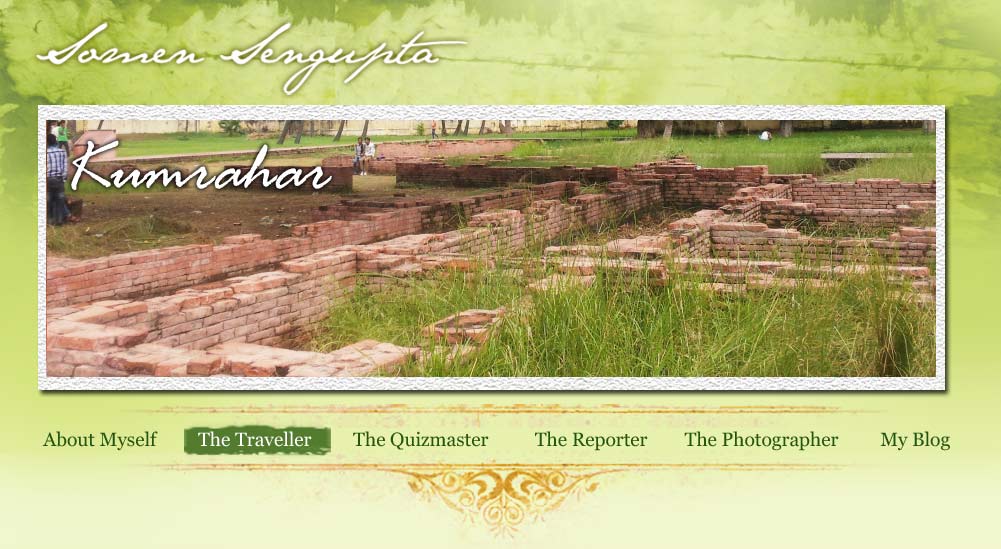| KUMRAHAR SOLE REMINDER OF AN ANCIENT CAPITAL |
|
Kumrahar is the site beneath which sleeps a city — the lost Pataliputra. Both in its richness and town planning, it was in no way inferior to any of its contemporary cities in the world. But sadly, it has hardly any significant remains to exhibit, says Somen Sengupta
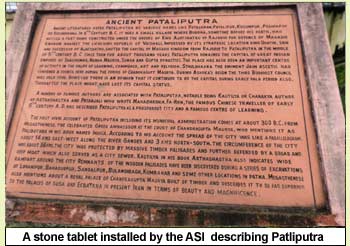 Our history avows with pride that Pataliputra was the most glorious capital of the ancient era, and it was where today's Patna city stands. If this is history, then why are there no archaeological ruins in or around Patna where the edifice of the great city — from where this country was ruled for more than 600 years — can be seen? Why don't we have any majestic ruins of the royal seat like those in ancient Italy or Greece? Our history avows with pride that Pataliputra was the most glorious capital of the ancient era, and it was where today's Patna city stands. If this is history, then why are there no archaeological ruins in or around Patna where the edifice of the great city — from where this country was ruled for more than 600 years — can be seen? Why don't we have any majestic ruins of the royal seat like those in ancient Italy or Greece?
This question called for a visit to the Kumrahar Archeological Park, just 6 km from Patna station. A stone tablet installed by the ASI answered a disturbing but fundamental question. Soon, I realised that I am walking on a ground under which a massive archaeological excavation site is buried. It is Pataliputra, the glory of our pristine past. And both in its richness and town planning, it was in no way inferior to any city in the world. The only difference is that today when a plethora of archeological ruins and excavation sites are carefully preserved in all ancient capitals of the world to showcase their extraordinary past, Pataliputra — from where four royal dynasties ruled India — has hardly any significant remains to exhibit.
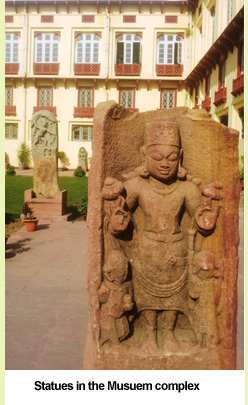 Thanks to the British officers of ASI, at least some signs of that city are visible in Kumrahar. Legend and history both have an equal share in forming the biography of the lost city. From these it is obvious that today's Patna city stands over a treasure box of archeological relics which are nothing but footprints of Pataliputra. Thanks to the British officers of ASI, at least some signs of that city are visible in Kumrahar. Legend and history both have an equal share in forming the biography of the lost city. From these it is obvious that today's Patna city stands over a treasure box of archeological relics which are nothing but footprints of Pataliputra.
The origin of the city finds its reference in mythology. Legends goes that King Putraka built the city in honour of his queen Patali and named it Pataligram. The name was changed to Pataliputra when she gave birth to her first son. A rational version explains that ‘Pattan' meaning port in Sanskrit or ‘Patali' meaning flower could have been the real inspiration for naming the city.
Buddhist texts suggest that when Buddha was undertaking his last journey towards the north from Vaishali, he came across Pataligram where he witnessed the construction of a fort by King Ajatshatru to protect his kingdom from the attack of Licchavies. At that time, Magadha's capital was Rajagriha. Soon, Udayin, the son of Ajatshatru, shifted the capital to Pataliputra. That was the beginning of a glorious journey of a great city. The journey ended after 1,100 years when the last few weak Gupta rulers failed to hold the kingdom. Frequent floods, attack by invaders and gradual deurbanisation turned the city into a necropolis. It soon sunk into the dark, forgotten pages of history.
Chinese travellers Fa-Hien in the 5th century and Xuanzang in the 7th century visited the place, but by that time it was already a ghost city. The best description of Pataliputra was found in the writings of Megasthenes, the Greek ambassador in the court of Chandragupta Maurya. In his book Indica, he referred to the city as Patlibothra, describing it shaped as a parallelogram running 12.5-km-long east to west and having a width of 2.4 km. Situated between Ganga, Punpun and Gondak rivers, the city was exposed to frequent flooding. The beautiful city was encircled by a timber palisade, which had 570 towers and 64 gates. There was a broad and deep moat around the wall, providing protection and serving as a sewage canal. He gave an illustrative description of Chandragupta's palace, clearly mentioning it as being much superior to the palace of Susa and Ecbatana of Iran.
Forgotten till the early 19th century, there was no effort to find the banished city, but the dream of finding ancient Pataliputra always hounded archaeologists. In the early 19th century, Buchanan and Rennel first made an effort. After that Alexandar Cunningham and JD Begler also tried to discover Pataliputra with not much success. It was concluded that the city was washed away and its ruins were under water.
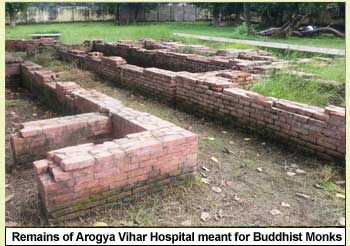 The real credit of finding ancient Pataliputra goes to Dr Laurence Austine Waddell, a legendary British explorer. It was he who in 1892 first wrote an article ‘Discovery of the exact site of Asoka's classical capital of Pataliputra, the Palibothra of the Greeks', after discovering wooden beams arranged in double rows and a wooden drain. At a place called Bulandibagh near Patna, he unearthed a column capital. Waddell took reference from Xuanxang, who in his travelogue, had mentioned two Ashoka pillars, which he named Jambudavipa and Nilli. Waddell was sure that he had discovered Nilli pillar. In the true sense, Waddell was the real explorer of Pataliputra. His article created mayhem across the world. The real credit of finding ancient Pataliputra goes to Dr Laurence Austine Waddell, a legendary British explorer. It was he who in 1892 first wrote an article ‘Discovery of the exact site of Asoka's classical capital of Pataliputra, the Palibothra of the Greeks', after discovering wooden beams arranged in double rows and a wooden drain. At a place called Bulandibagh near Patna, he unearthed a column capital. Waddell took reference from Xuanxang, who in his travelogue, had mentioned two Ashoka pillars, which he named Jambudavipa and Nilli. Waddell was sure that he had discovered Nilli pillar. In the true sense, Waddell was the real explorer of Pataliputra. His article created mayhem across the world.
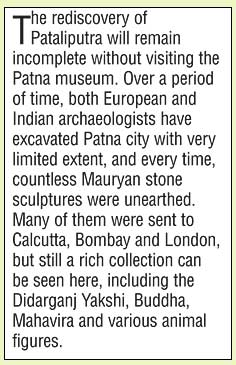 He had a grand plan to excavate more but a transfer order moved him to Calcutta to teach chemistry in Calcutta Medical College. So, the excavation was handed over to PC Mukherjee, who in 1897 found a ditch along with many stone fragments and coins of Chandragupta-II. The discovery of the ditch matched with the description of Megasthenes, and the existence of Pataliputra under the base of Patna city was cemented with this. He had a grand plan to excavate more but a transfer order moved him to Calcutta to teach chemistry in Calcutta Medical College. So, the excavation was handed over to PC Mukherjee, who in 1897 found a ditch along with many stone fragments and coins of Chandragupta-II. The discovery of the ditch matched with the description of Megasthenes, and the existence of Pataliputra under the base of Patna city was cemented with this.
In 1912, industrialist Sir Ratanji Tata of Bombay's Tata Sons expressed his desire to fund the archeological excavation. A budget of Rs20,000 per year — a princely sum at that time — was sanctioned. His condition was that the ASI should undertake excavation at the Buddhist site of Peshawar province and all artifacts unearthed from the project be sent to the Prince of Wales Museum in Bombay, which was then in its formation phase.
However, the ASI chose Pataliputra over Peshawar for excavation, and this time the project site was shifted to Kumrahar. A young American archaeologist named David Brainerd Spooner excavated the same village from another side. Bad weather, floods and some local issues affected the pace of work, but on February 7, 1913, he discovered one of the richest archaeological treasures of India. He first found a brick wall under a structure and beneath that found 30 cm thick charcoal and ashes. Once that layer was removed, a huge square sub-structure with 72 massive Mauryan sandstone pillars made of black spotted buff sandstone monoliths were unearthed. The pillars were 15 ft apart and were arranged in eight rows.
He also found a series of parallel wooden platforms. Of the 72 pillars, only one column was found intact; the rest were broken. His excavation again established the fact that there was indeed a great city called Pataliputra. Spooner soon concluded that this huge structure was a grand conference hall where Ashoka conducted the third Buddhist council. As he could not match the structure with any present classical Indian structure, he also concluded that this palace was a replica of the great Persian structure hall of Persepolis. However, his theory was not accepted by many.
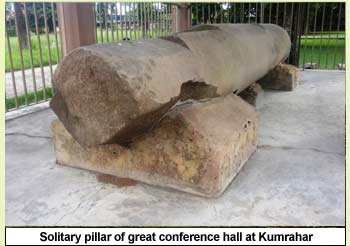 The project stopped due to heavy flooding in 1913. In mid-1914, Spooner re-excavated Bulandibagh and found a wooden palisade, which was the boundary wall of the city described by Megasthenes. Soon excavation entered a Muslim burial ground and with that all work stopped. In 1927, this place was again excavated by JA Page and M Ghosh. They unearthed a wooden wall made of heavy sleepers placed vertically in a double row with similar sleepers joining them horizontally from the bottom. Once again, Megasthenes's 2,000-year-old description came under light. The project stopped due to heavy flooding in 1913. In mid-1914, Spooner re-excavated Bulandibagh and found a wooden palisade, which was the boundary wall of the city described by Megasthenes. Soon excavation entered a Muslim burial ground and with that all work stopped. In 1927, this place was again excavated by JA Page and M Ghosh. They unearthed a wooden wall made of heavy sleepers placed vertically in a double row with similar sleepers joining them horizontally from the bottom. Once again, Megasthenes's 2,000-year-old description came under light.
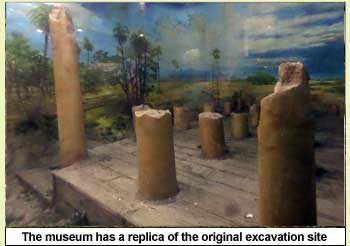 From 1951-1955, AS Altekar and V Mishra from KP Jaiswal Research Institute conducted another excavation. It unearthed eight more pillar pits apart from the 72 already discovered by Spooner, and also found the ruins of a brick structure dating back to the 5th century. A terracotta seal found on the same spot read: “Arogyavihare Bikshusamghasya”. A seal was also found curved with the word ‘Dhanvantareah' written in Gupta Bramhi script. A plethora of antiquities like copper coins, ornaments, antimony rods, terracotta seals, dice made of ivory, and toy carts were also excavated. From 1951-1955, AS Altekar and V Mishra from KP Jaiswal Research Institute conducted another excavation. It unearthed eight more pillar pits apart from the 72 already discovered by Spooner, and also found the ruins of a brick structure dating back to the 5th century. A terracotta seal found on the same spot read: “Arogyavihare Bikshusamghasya”. A seal was also found curved with the word ‘Dhanvantareah' written in Gupta Bramhi script. A plethora of antiquities like copper coins, ornaments, antimony rods, terracotta seals, dice made of ivory, and toy carts were also excavated.
After this discovery, it was clear that legendary doctor of the Gupta era, Dhyanantari was indeed a man of medical repute and this was his hospital meant for Buddhist monks. The word Arogya Vihar by its literary merit means a hospital. The remains of the hospital can be seen today but only in a minimum form. The actual excavation trench of the palace of 80 pillars is no more visible today. As the area is still prone to floods. The Government had buried the entire site with soil in 1989. A museum at the site has a small replica of the original excavation and that is the only visual delight to have a feel of how the site looked like when it was explored in 1913. The museum also houses various artifacts found at the site.
A solitary pillar on display, with some inscription on the front, now rests under a covered and fenced shade. The pillar of the great conference hall is good enough to give you the idea of its shape and size. It carries the testimony of an extraordinary level of archeology and engineering of a time when the rest of the world could not have imagined it. This solitary pillar along with the Arogyashala are the last signatures of an ancient city which we will never be able to see again.
This article was published on 28th June 2015 in The Pioneer
Click here to view the original article |
